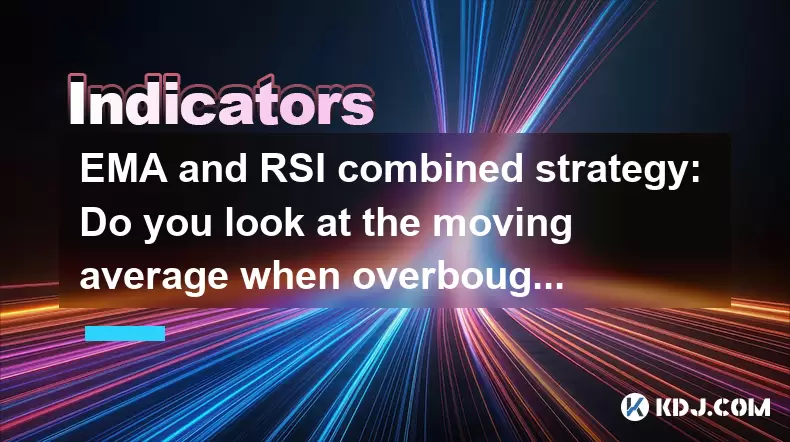-
 bitcoin
bitcoin $112195.049338 USD
2.42% -
 ethereum
ethereum $4124.915858 USD
2.81% -
 tether
tether $1.000570 USD
0.02% -
 xrp
xrp $2.861568 USD
2.25% -
 bnb
bnb $1000.346670 USD
3.04% -
 solana
solana $209.070819 USD
3.38% -
 usd-coin
usd-coin $0.999870 USD
0.02% -
 dogecoin
dogecoin $0.235379 USD
2.65% -
 tron
tron $0.335681 USD
-0.20% -
 cardano
cardano $0.803501 USD
3.38% -
 hyperliquid
hyperliquid $47.120881 USD
3.56% -
 chainlink
chainlink $21.501300 USD
3.44% -
 ethena-usde
ethena-usde $1.000571 USD
0.02% -
 avalanche
avalanche $29.793378 USD
3.62% -
 stellar
stellar $0.366964 USD
2.42%
EMA and RSI combined strategy: Do you look at the moving average when overbought or oversold?
EMA, giving more weight to recent prices, and RSI, measuring price movement speed, together form a robust strategy for crypto trading decisions.
May 21, 2025 at 11:42 pm

Introduction to EMA and RSI
The Exponential Moving Average (EMA) and the Relative Strength Index (RSI) are two widely used technical indicators in the cryptocurrency trading world. EMA provides a weighted average of a cryptocurrency's price over a specific period, giving more importance to recent prices. RSI, on the other hand, measures the speed and change of price movements to determine overbought or oversold conditions. Combining these two indicators can offer a robust trading strategy that helps traders make informed decisions.
Understanding the EMA
The EMA is a type of moving average that places greater emphasis on the most recent data points. This makes it more responsive to new information compared to the Simple Moving Average (SMA). In cryptocurrency trading, the most commonly used EMA periods are 9, 21, and 50 days. The EMA can help traders identify trends and potential reversal points by smoothing out price data.
To calculate the EMA, the following formula is used:
[ \text{EMA} = \left( \text{Price} - \text{Previous EMA} \right) \times \left( \frac{2}{\text{Periods} + 1} \right) + \text{Previous EMA} ]
This formula ensures that the most recent prices have a greater impact on the moving average.
Understanding the RSI
The RSI is a momentum oscillator that measures the speed and change of price movements. It ranges from 0 to 100 and is typically used to identify overbought or oversold conditions. An RSI value above 70 suggests that an asset is overbought, while an RSI value below 30 indicates that it is oversold. The standard period for RSI calculation is 14 days.
The formula to calculate RSI is:
[ \text{RSI} = 100 - \left( \frac{100}{1 + \text{RS}} \right) ]
Where RS (Relative Strength) is the average gain of up periods divided by the average loss of down periods over the specified period.
Combining EMA and RSI
Combining EMA and RSI can provide a more comprehensive view of the market. Traders often look at the EMA to confirm the overall trend and use RSI to identify entry and exit points within that trend. When the RSI indicates an overbought or oversold condition, traders can use the EMA to assess whether the current trend is likely to continue or reverse.
Looking at the Moving Average When Overbought or Oversold
When the RSI indicates that a cryptocurrency is overbought or oversold, it's crucial to consider the EMA to make informed trading decisions. If the RSI is above 70 (overbought) and the price is above the EMA, it might suggest that the bullish trend is strong, and a pullback could be a buying opportunity. Conversely, if the RSI is below 30 (oversold) and the price is below the EMA, it might indicate a strong bearish trend, and a bounce could be a selling opportunity.
However, if the RSI is overbought and the price is below the EMA, it might signal a potential reversal. Similarly, if the RSI is oversold and the price is above the EMA, it could indicate that the downtrend is weakening, and a bullish reversal might be imminent.
Implementing the EMA and RSI Combined Strategy
To implement this strategy, follow these steps:
- Choose the right timeframe: Decide on the trading timeframe that suits your trading style. Common timeframes include 1-hour, 4-hour, and daily charts.
- Select the EMA periods: Choose the EMA periods that you will use. Popular choices are the 9-day, 21-day, and 50-day EMAs.
- Set up the RSI: Use the standard 14-day RSI setting.
- Monitor the indicators: Watch the price in relation to the EMA and the RSI readings.
- Identify trading opportunities:
- If the RSI is overbought (above 70) and the price is above the EMA, look for a pullback to enter a long position.
- If the RSI is oversold (below 30) and the price is below the EMA, look for a bounce to enter a short position.
- If the RSI is overbought and the price is below the EMA, consider a potential bearish reversal and look for shorting opportunities.
- If the RSI is oversold and the price is above the EMA, consider a potential bullish reversal and look for buying opportunities.
Practical Example of the Strategy
Let's consider a practical example using Bitcoin (BTC) on a daily chart:
- EMA settings: 9-day and 21-day EMAs.
- RSI setting: 14-day RSI.
Suppose the price of BTC is trading above the 21-day EMA, indicating a bullish trend. The RSI is currently at 72, suggesting that BTC is overbought.
- Action: Since the price is above the 21-day EMA and the RSI is overbought, traders might look for a pullback to the 9-day EMA as a potential buying opportunity. If the price pulls back to the 9-day EMA and the RSI drops below 70, it could be a good entry point for a long position.
Now, let's consider another scenario where the price of BTC is trading below the 21-day EMA, indicating a bearish trend. The RSI is currently at 28, suggesting that BTC is oversold.
- Action: Since the price is below the 21-day EMA and the RSI is oversold, traders might look for a bounce to the 9-day EMA as a potential selling opportunity. If the price bounces to the 9-day EMA and the RSI rises above 30, it could be a good entry point for a short position.
Fine-Tuning the Strategy
While the basic strategy involves using the EMA to confirm the trend and the RSI to identify overbought or oversold conditions, traders can fine-tune this approach by:
- Using multiple EMAs: Instead of relying on a single EMA, traders can use multiple EMAs (e.g., 9-day, 21-day, and 50-day) to get a clearer picture of the trend.
- Adjusting RSI settings: The standard 14-day RSI setting can be adjusted to be more or less sensitive. For example, using a 9-day RSI can make it more responsive to price changes, while a 21-day RSI can provide a smoother signal.
- Combining with other indicators: Traders can combine the EMA and RSI with other indicators, such as the Moving Average Convergence Divergence (MACD) or Bollinger Bands, to enhance their trading strategy.
Risk Management
Effective risk management is crucial when using any trading strategy. Here are some tips for managing risk with the EMA and RSI combined strategy:
- Set stop-loss orders: Always use stop-loss orders to limit potential losses. The stop-loss level can be set just below the 9-day EMA for long positions or just above the 9-day EMA for short positions.
- Position sizing: Determine the appropriate position size based on your risk tolerance and account size. Never risk more than a small percentage of your trading capital on a single trade.
- Diversify: Don't put all your eggs in one basket. Consider diversifying your trades across different cryptocurrencies to spread the risk.
- Monitor market conditions: Be aware of market conditions and news events that could impact cryptocurrency prices. Adjust your trading strategy accordingly.
Frequently Asked Questions
Q: Can the EMA and RSI strategy be used on any cryptocurrency?A: Yes, the EMA and RSI strategy can be applied to any cryptocurrency. However, the effectiveness of the strategy may vary depending on the liquidity and volatility of the specific cryptocurrency. More liquid and less volatile cryptocurrencies tend to produce more reliable signals.
Q: How often should I check the EMA and RSI indicators?A: The frequency of checking the EMA and RSI indicators depends on your trading timeframe. For day traders using 1-hour or 4-hour charts, checking the indicators every few hours is advisable. For swing traders using daily charts, checking the indicators once or twice a day may be sufficient.
Q: What other technical indicators can I use to complement the EMA and RSI strategy?A: Other technical indicators that can complement the EMA and RSI strategy include the Moving Average Convergence Divergence (MACD), Bollinger Bands, and the Stochastic Oscillator. These indicators can provide additional confirmation signals and help traders make more informed decisions.
Q: Is it necessary to use both the 9-day and 21-day EMAs, or can I use just one?A: Using both the 9-day and 21-day EMAs can provide a more comprehensive view of the trend. The 9-day EMA is more sensitive and can help identify short-term trends, while the 21-day EMA can confirm longer-term trends. However, if you prefer a simpler approach, using just one EMA (e.g., the 21-day EMA) can still be effective.
Disclaimer:info@kdj.com
The information provided is not trading advice. kdj.com does not assume any responsibility for any investments made based on the information provided in this article. Cryptocurrencies are highly volatile and it is highly recommended that you invest with caution after thorough research!
If you believe that the content used on this website infringes your copyright, please contact us immediately (info@kdj.com) and we will delete it promptly.
- Navigating Misinformation: Ensuring Safety in the Pi Network Ecosystem
- 2025-09-29 14:25:13
- XRP Price Prediction: September 29th's Crypto Comeback?
- 2025-09-29 14:25:13
- Polkadot vs. Lyno AI: Decoding the Price Forecast and AI Revolution
- 2025-09-29 14:30:01
- Ruvi AI: Revolutionizing the Creator Economy with AI-Powered Crypto
- 2025-09-29 14:30:01
- PayOS, Agentic Commerce, and Token Transactions: The Future is Now, Baby!
- 2025-09-29 14:30:01
- AI, Crypto Tokens, and the Digital Revolution: A New York State of Mind
- 2025-09-29 14:30:13
Related knowledge

What is a tower bottom candlestick pattern? Does it have a high success rate?
Sep 22,2025 at 07:18am
Tower Bottom Candlestick Pattern Explained1. The tower bottom candlestick pattern is a reversal formation that typically appears at the end of a downt...

What is a black hole pattern in the MACD indicator? Is it a cause for concern?
Sep 21,2025 at 06:54pm
Bitcoin's Role in Decentralized Finance1. Bitcoin remains the cornerstone of decentralized finance, serving as a benchmark for value and security acro...

How can I use the psychological line (PSY) to determine market sentiment?
Sep 17,2025 at 02:19pm
Understanding the Psychological Line (PSY) in Cryptocurrency TradingThe Psychological Line, commonly referred to as PSY, is a momentum oscillator used...

How can I determine if a double top pattern has officially formed?
Sep 21,2025 at 03:18am
Understanding the Structure of a Double Top Pattern1. A double top pattern consists of two distinct peaks that reach approximately the same price leve...

What is the Golden Valley pattern on the moving average? Is it better than the Silver Valley pattern?
Sep 21,2025 at 02:54pm
Understanding the Golden Valley Pattern in Moving Averages1. The Golden Valley pattern is a technical formation observed in cryptocurrency price chart...

What does a death cross of the RSI in the strong zone (above 50) mean?
Sep 17,2025 at 10:54pm
Understanding the Death Cross in RSI Context1. The term 'death cross' is traditionally associated with moving averages, where a short-term average cro...

What is a tower bottom candlestick pattern? Does it have a high success rate?
Sep 22,2025 at 07:18am
Tower Bottom Candlestick Pattern Explained1. The tower bottom candlestick pattern is a reversal formation that typically appears at the end of a downt...

What is a black hole pattern in the MACD indicator? Is it a cause for concern?
Sep 21,2025 at 06:54pm
Bitcoin's Role in Decentralized Finance1. Bitcoin remains the cornerstone of decentralized finance, serving as a benchmark for value and security acro...

How can I use the psychological line (PSY) to determine market sentiment?
Sep 17,2025 at 02:19pm
Understanding the Psychological Line (PSY) in Cryptocurrency TradingThe Psychological Line, commonly referred to as PSY, is a momentum oscillator used...

How can I determine if a double top pattern has officially formed?
Sep 21,2025 at 03:18am
Understanding the Structure of a Double Top Pattern1. A double top pattern consists of two distinct peaks that reach approximately the same price leve...

What is the Golden Valley pattern on the moving average? Is it better than the Silver Valley pattern?
Sep 21,2025 at 02:54pm
Understanding the Golden Valley Pattern in Moving Averages1. The Golden Valley pattern is a technical formation observed in cryptocurrency price chart...

What does a death cross of the RSI in the strong zone (above 50) mean?
Sep 17,2025 at 10:54pm
Understanding the Death Cross in RSI Context1. The term 'death cross' is traditionally associated with moving averages, where a short-term average cro...
See all articles










































































